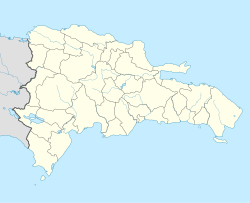Sabaneta, Santiago Rodríguez facts for kids
Quick facts for kids
Sabaneta
|
||
|---|---|---|
|
Municipality
|
||
| San Ignacio de Sabaneta | ||
|
||
| Country | ||
| Province | Santiago Rodríguez | |
| Founded | 1844 | |
| Municipality since | 1858 | |
| Municipal Districts | None | |
| Area | ||
| • Total | 801.4 km2 (309.4 sq mi) | |
| Elevation | 124 m (407 ft) | |
| Population
(2010)
|
||
| • Total | 34,540 | |
| • Density | 43.100/km2 (111.627/sq mi) | |
| • Urban | 15,648 | |
| Time zone | UTC-4 (AST) | |
| • Summer (DST) | UTC-4 (AST) | |
| Distance | 95 km (59 mi) to Santiago 245 km (152 mi) to Santo Domingo |
|
San Ignacio de Sabaneta is a lively city and a special kind of local government area called a municipality in the northwest part of the Dominican Republic. It's the most important city in the Santiago Rodríguez province. Most people just call it Sabaneta or Santiago Rodríguez.
Contents
History of Sabaneta
The town of Sabaneta was started in 1844. A person named Santiago Rodríguez and others founded it. They chose a spot in a small savanna, which is a grassy plain. The name Sabaneta actually means "small savanna." This area is north of the Cordillera Central mountain range.
In 1854, Sabaneta became a "Military Post." This meant it was an important place for the army. A few years later, in 1858, it officially became a municipality. At that time, it was part of the Santiago province.
San Ignacio de Sabaneta played a big role in the fight against the Spanish soldiers. This happened during the first part of the Restoration War, which lasted from 1863 to 1865.
Later, in 1879, a new province called Monte Cristi was created. San Ignacio de Sabaneta then became a municipality within this new province. Finally, in 1948, the Santiago Rodríguez province was formed. San Ignacio de Sabaneta was chosen to be its main city, also known as the provincial capital.
Population in Sabaneta
In 2010, the city of San Ignacio de Sabaneta had a total population of 34,540 people. Out of these, 17,935 were men and 16,605 were women.
About 45% of the people lived in the city areas. This means 15,648 people lived in the urban parts of Sabaneta. The rest lived in the surrounding rural areas.
Geography of Sabaneta
San Ignacio de Sabaneta is located on the northern side of the Cordillera Central. This is a large "Central mountain range" in the Dominican Republic. The total area of the municipality is about 801.4 square kilometers (309.4 square miles). This makes up about 70% of the entire Santiago Rodríguez province.
The city is about 124 meters (407 feet) above sea level. It is also about 245 kilometers (152 miles) northwest of Santo Domingo, the capital city.
The municipality of San Ignacio de Sabaneta does not have any smaller divisions called municipal districts.
Sabaneta is surrounded by several other provinces and municipalities:
- To the north, it borders the Monte Cristi province.
- To the northwest, it is next to the municipality of Monción.
- The Santiago province is to the west.
- To the southeast, you'll find the San Juan province.
- The Elías Piña province is to the south.
- Finally, to the west, it borders the municipality of Villa Los Almácigos and the Dajabón province.
Climate in Sabaneta
San Ignacio de Sabaneta has a tropical climate. This means it's generally warm all year round. It's known as a wet and dry/savanna climate. This type of climate has a clear dry season during the winter months.
The city gets about 1187.9 millimeters (46.8 inches) of rainfall each year on average.
- The wettest month is usually May, with about 202.2 millimeters (8.0 inches) of rain.
- October is also quite rainy, with about 149.3 millimeters (5.9 inches).
The driest time of year is winter.
- January is the driest month, with only about 33 millimeters (1.3 inches) of rain.
- December is also quite dry, with about 35.3 millimeters (1.4 inches).
Sabaneta is a warm place. The average temperature for the whole year is about 26.2°C (79.2°F).
- The warmest month is usually August, with an average temperature of 27.6°C (81.7°F).
- The coolest month is January, with an average temperature of 24.2°C (75.6°F).
| Climate data for San Ignacio de Sabaneta (1961–1990) | |||||||||||||
|---|---|---|---|---|---|---|---|---|---|---|---|---|---|
| Month | Jan | Feb | Mar | Apr | May | Jun | Jul | Aug | Sep | Oct | Nov | Dec | Year |
| Mean daily maximum °C (°F) | 31.3 (88.3) |
32.1 (89.8) |
32.6 (90.7) |
32.7 (90.9) |
33.0 (91.4) |
33.5 (92.3) |
34.2 (93.6) |
34.3 (93.7) |
33.9 (93.0) |
33.5 (92.3) |
32.2 (90.0) |
31.1 (88.0) |
32.9 (91.2) |
| Daily mean °C (°F) | 24.2 (75.6) |
24.9 (76.8) |
25.6 (78.1) |
26.1 (79.0) |
26.2 (79.2) |
27.1 (80.8) |
27.6 (81.7) |
27.6 (81.7) |
27.3 (81.1) |
27 (81) |
25.6 (78.1) |
24.4 (75.9) |
26.1 (79.1) |
| Mean daily minimum °C (°F) | 17.1 (62.8) |
17.7 (63.9) |
18.5 (65.3) |
19.5 (67.1) |
20.5 (68.9) |
20.7 (69.3) |
20.9 (69.6) |
20.9 (69.6) |
20.6 (69.1) |
20.4 (68.7) |
19.0 (66.2) |
17.7 (63.9) |
19.5 (67.0) |
| Average rainfall mm (inches) | 33.0 (1.30) |
36.9 (1.45) |
43.6 (1.72) |
125.7 (4.95) |
202.2 (7.96) |
149.2 (5.87) |
75.8 (2.98) |
88.8 (3.50) |
141.8 (5.58) |
149.3 (5.88) |
106.3 (4.19) |
35.3 (1.39) |
1,187.9 (46.77) |
| Source 1: NOAA | |||||||||||||
| Source 2: Climatemps.com | |||||||||||||
Economy of Sabaneta
The main way people make a living in San Ignacio de Sabaneta is through farming. This includes growing crops like tobacco. They also raise cattle to produce milk. These activities are very important for the local economy.
| Provincial capitals of the Dominican Republic | |
|---|---|
| Azua • Baní • Barahona • Bonao • Comendador • Cotuí • Dajabón • El Seibo • Hato Mayor • Higüey • Jimaní • La Romana • La Vega • Mao • Moca • Monte Cristi • Monte Plata • Nagua • Neiba • Pedernales • Puerto Plata • Sabaneta • Salcedo • Samaná • San Cristóbal • San Francisco de Macorís • San José de Ocoa • San Juan de la Maguana • San Pedro de Macorís • Santiago de los Caballeros • Santo Domingo • Santo Domingo Este | |



